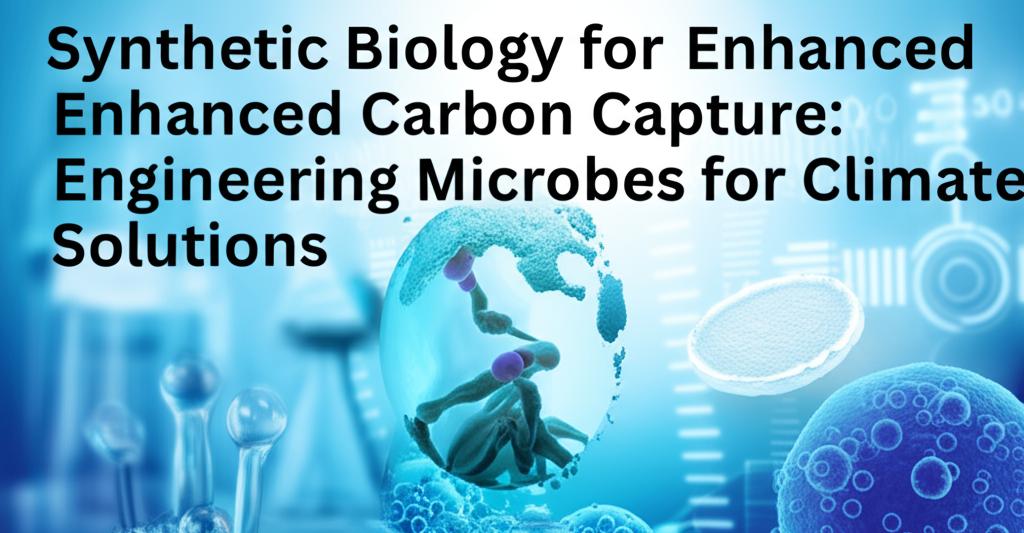Engineering Our Way Out of a Carbon Crisis: The Rise of Synthetic Biology
The fight against climate change has a powerful new ally: synthetic biology. Imagine microscopic factories, not churning out plastics or chemicals, but diligently pulling excess carbon dioxide (CO2) from our atmosphere. This isn't science fiction; it's the cutting edge of research where scientists are reprogramming microbes to become super-efficient carbon capture machines.
For too long, we've relied on natural processes that are struggling to keep pace with our emissions. Enter synthetic biology, a field that allows us to design and build new biological parts, devices, and systems, or to re-engineer existing, natural biological systems for useful purposes. When applied to carbon capture, this means we can enhance the natural abilities of microorganisms like bacteria and algae to absorb and convert CO2.
How Does It Work?At its core, this approach involves genetically engineering microbes to optimize their carbon fixation pathways. Scientists are identifying and tweaking the genes responsible for CO2 uptake and conversion. This could mean:
- Boosting Photosynthesis: For photosynthetic microbes like algae and cyanobacteria, researchers are enhancing the efficiency of light capture and the enzymes involved in converting CO2 into organic carbon. Think of it as giving these tiny powerhouses a turbo boost.
- Creating Novel Carbon Pathways: Scientists are designing entirely new metabolic pathways in microbes, enabling them to consume CO2 and transform it into valuable bioproducts. This not only sequesters carbon but also creates sustainable alternatives to fossil fuel-derived materials. Imagine microbes that "eat" CO2 and produce biofuels, bioplastics, or even food ingredients.
- Improving Resilience and Efficiency: Natural microbes often have limitations. Synthetic biology allows us to engineer them to thrive in harsh industrial conditions, tolerate higher CO2 concentrations, and resist contamination, making them more practical for large-scale deployment.
- Designing "Smart" Microbes: Future applications could see microbes engineered to respond to specific environmental cues, activating their carbon capture mechanisms only when and where they are needed most.
A truly exciting aspect of this field is the concept of "carbon upcycling." Instead of just storing the captured CO2, engineered microbes can convert it into a wide array of useful products. This creates a circular carbon economy, where CO2 is not a waste product but a valuable feedstock. This approach offers economic incentives that can help drive the adoption of carbon capture technologies.
Current Breakthroughs and Future PromiseRecent advancements have been nothing short of remarkable. Researchers are successfully demonstrating enhanced CO2 fixation rates in engineered strains in laboratory settings. Companies are beginning to explore pilot-scale projects to test these "super microbes" in real-world environments, such as in bioreactors attached to industrial exhaust streams or even in open pond systems for algae.
The potential is immense. Imagine vast arrays of bioreactors filled with engineered microbes, silently scrubbing CO2 from power plants or cement factories. Picture agricultural lands where engineered soil microbes not only enhance plant growth but also lock away more carbon in the ground.
Challenges on the HorizonOf course, the path to widespread implementation isn't without its hurdles. Scaling up these technologies from the lab to industrial levels is a significant engineering challenge. Ensuring the long-term stability and containment of genetically engineered organisms in natural environments is another crucial consideration that requires careful risk assessment and regulatory oversight. The cost-effectiveness of these synthetic biology solutions also needs to be competitive with other carbon capture methods.
A Greener Tomorrow, Engineered TodayDespite these challenges, the momentum behind synthetic biology for carbon capture is undeniable. The ability to precisely design and engineer life offers an unprecedented toolkit in our global effort to mitigate climate change. By harnessing the power of the smallest organisms, we are opening up new and exciting avenues for creating a more sustainable and carbon-neutral future. The microscopic world is poised to make a macroscopic impact.

